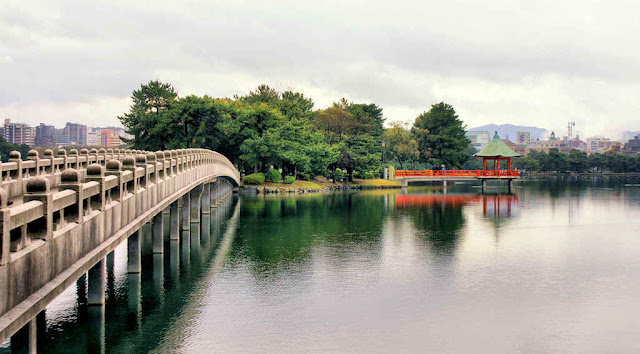Fukuoka Castle is said to have been the biggest castle in Kyushu, though I believe that means covering the largest area.
Much of the former castle is now Maizuru Park, a huge park with multiples sports grounds and stadiums within it.
The park is also home to numerous gardens planted with different seasonall plants and trees like a Cherry garden, Plum Garden, Iris Garden, and an Azalea Garden.
I visited a little after the peak of the cherry blossoms around the inner area of the castle ruins and on an overcast day.
Other than extensive walls, the most impressive of the remaining original structures is the Tamon Yagura Turret featured in the first few photos.
The castle was constructed between 1601 and 1607 for Kuroda Nagamasa who had been given the domain and nearby Najima Castle which he decided was too small and inconvenient for the building of a catle town.
One of the men responsible for the construction, Noguchi Kazanari, also worked on Osaka Castle and Edo Castle.
When Kato Kiyomasa, the famous Daimyo from Kumamoto, visited he was so impressed with the extensive stonework he named it Seki Castle, literally stone castle.
Covering 47,000 square meters, and with an impressive 47 yagura, much of the stone was quarried on nearby islands, though stones from the dismantled Najima castle and even stones from the fortifications built in preparation for the Mongol Invasion were also used.
Also impressive was the moat system which included a 600 meter wide section to the west that was mostly mud flats at low tide, now turned into Ohori Park.
There are conficting theories on whether a Tenshu, main tower or keep, was actually built. A base was but there seems to be no evidence that one existed, although that may be because in his hatred of Chrsitianity, Kuroda Nagamasa destroyed all documents with the word "tenshu" because it also meant "Christian God".
Like many castle in Japan, in 1871 when the han system was abandoned most of the buildings of the castle were dismantled or destroyed but a couple have recently been returned to ther original site from temples where they had been reassembled.
Maizuru Park and the Fukuoka Castle Ruins are free to enter
The previous post in this series was on
Ohori Park, previously the very wide moat that protected the castle from the wesr.



































































